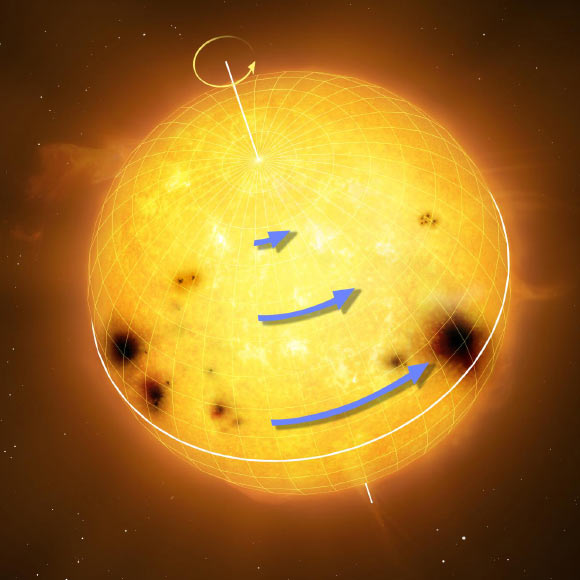Our Sun rotates faster at its equator than at its poles. This process is known as differential rotation and is seen in the motion of sunspots. Now, a team of astronomers has used NASA’s Kepler Space Telescope to measure the rotational patterns of a group of Sun-like stars. They have identified 13 stars that rotate in a similar fashion as our Sun — their equators rotate up to 2.5 times faster than their poles.

Sun-like stars rotate differentially, with the equator rotating faster than the higher latitudes. The blue arrows in the figure represent rotation speed. Differential rotation is thought to be an essential ingredient for generating magnetic activity and starspots. Image credit: MPI for Solar System Research / MarkGarlick.com.
Observations of sunspots on the surface of our Sun demonstrate that the equator rotates 30% faster than the poles.
Analysis of the Sun’s acoustic oscillations shows that this differential rotation extends deep into the interior.
This has led to valuable insights into the Sun’s structure and may explain how the solar magnetic field is sustained.
However, little is known about rotational characteristics of other Sun-like stars and the methods for investigating the phenomenon are limited.
Dr. Othman Benomar of New York University, Abu Dhabi, and co-authors used the Kepler spacecraft to monitor the stellar oscillations of 40 Sun-like stars.
They found that 13 Sun-like stars do indeed rotate in a similar manner as the Sun in that their equatorial regions rotate more rapidly than at mid- to high latitudes.
But there’s a key difference. The equator of the Sun rotates about 10% faster than its mid latitudes, while equators of Sun-like stars spin up to two times faster than their mid latitudes.
“This is very unexpected, and challenges current numerical simulations, which suggest that stars like these should not be able to sustain differential rotation of this magnitude,” Dr. Benomar said.
“Understanding differential rotation is not only important for a complete understanding of how a star works, it will help us gain deeper insights about their magnetic fields,” added Dr. Katepalli Sreenivasan, principal investigator of the Center for Space Science at New York University, Abu Dhabi.
“Our best measurements all reveal stars with Sun-like rotation,” said Dr. Laurent Gizon, a researcher at the Max-Planck-Institut für Sonnensystemforschung, the Georg-August-Universität Göttingen and New York University, Abu Dhabi.
“The most surprising aspect of this research is that latitudinal differential rotation can be much stronger in some stars than in the Sun.”
“We did not expect such large values, which are not predicted by numerical models.”
The findings were published in the September 21, 2018 issue of the journal Science.
_____
O. Benomar et al. 2018. Asteroseismic detection of latitudinal differential rotation in 13 Sun-like stars. Science 361 (6408): 1231-1234; doi: 10.1126/science.aao6571







